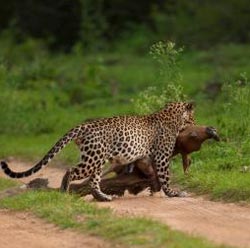Leopard in dramatic photo traced to 2004 camera trap

The leopard in this recent dramatic photograph has been linked to a camera trap image eight years ago taken in India. Credit: Vinay S. Kumar<br>
The photo, taken by Indian photographer Vinay S. Kumar, was initially submitted to Conservation India, a not-for-profit portal to enable conservation action. Intrigued by the picture, CI's editors sent it to researchers at Wildlife Conservation Society's India Program who have been running a tiger-monitoring program for over two decades – the longest in the world. Their huge database of camera trap pictures also includes hundreds of pictures of leopards.
The male was quickly identified, thanks to special computer software that can compare rosette patterns, as Bandipur Leopard #123 or BPL-123, which was first camera-trapped on December 2, 2004, according to Dr. N. Samba Kumar, Joint Director – Conservation Science, WCS – India.
The intensive, long-term camera trapping project, implemented by the Centre for Wildlife Studies, in collaboration with the Karnataka Forest Department, and with support from Wildlife Conservation Society, has yielded extremely valuable data on large carnivore densities, as well as recruitment and survival rates, all of which are crucial to gauge how big cat populations are faring. Research at Bandipur Tiger Reserve has shown that tiger densities are quite high (10-15 tigers/100 km2).
“Photographs can help track the life histories of individual tigers – and as can be seen in this case, leopards,” said Ullas Karanth, director of WCS's India Programs. “In this context, even photographs taken by tourists can be valuable in providing additional information. As this particular 'catch' shows, BPL – 123 is thriving, and his superb condition is perhaps an indicator of the health of his habitat too.”
Leopards are legendary for hauling prey much larger than themselves into trees to keep them from the clutches of other predators. The gaur in the image probably weighs about 100 kilograms (220 pounds), while a full-grown male Indian leopard on the other hand, would weigh between 50-70 kilograms (110- 154 pounds).
WCS's tiger and other big cat conservation work in India is made possible in part by the Liz Claiborne and Art Ortenberg Foundation, among other generous supporters. WCS collaborators on this project include the Karnataka Forest Department and National Tiger Conservation Authority.
The Wildlife Conservation Society saves wildlife and wild places worldwide. We do so through science, global conservation, education and the management of the world's largest system of urban wildlife parks, led by the flagship Bronx Zoo. Together these activities change attitudes towards nature and help people imagine wildlife and humans living in harmony. WCS is committed to this mission because it is essential to the integrity of life on Earth. Visit www.wcs.org.
PHOTO CREDIT (One-Time Use Only):
Leopard with Gaur: Vinay S. Kumar
Leopard in Camera Trap: Ullas Karanth/WCS
Media Contact
More Information:
http://www.wcs.orgAll latest news from the category: Ecology, The Environment and Conservation
This complex theme deals primarily with interactions between organisms and the environmental factors that impact them, but to a greater extent between individual inanimate environmental factors.
innovations-report offers informative reports and articles on topics such as climate protection, landscape conservation, ecological systems, wildlife and nature parks and ecosystem efficiency and balance.
Newest articles

High-energy-density aqueous battery based on halogen multi-electron transfer
Traditional non-aqueous lithium-ion batteries have a high energy density, but their safety is compromised due to the flammable organic electrolytes they utilize. Aqueous batteries use water as the solvent for…

First-ever combined heart pump and pig kidney transplant
…gives new hope to patient with terminal illness. Surgeons at NYU Langone Health performed the first-ever combined mechanical heart pump and gene-edited pig kidney transplant surgery in a 54-year-old woman…

Biophysics: Testing how well biomarkers work
LMU researchers have developed a method to determine how reliably target proteins can be labeled using super-resolution fluorescence microscopy. Modern microscopy techniques make it possible to examine the inner workings…





















